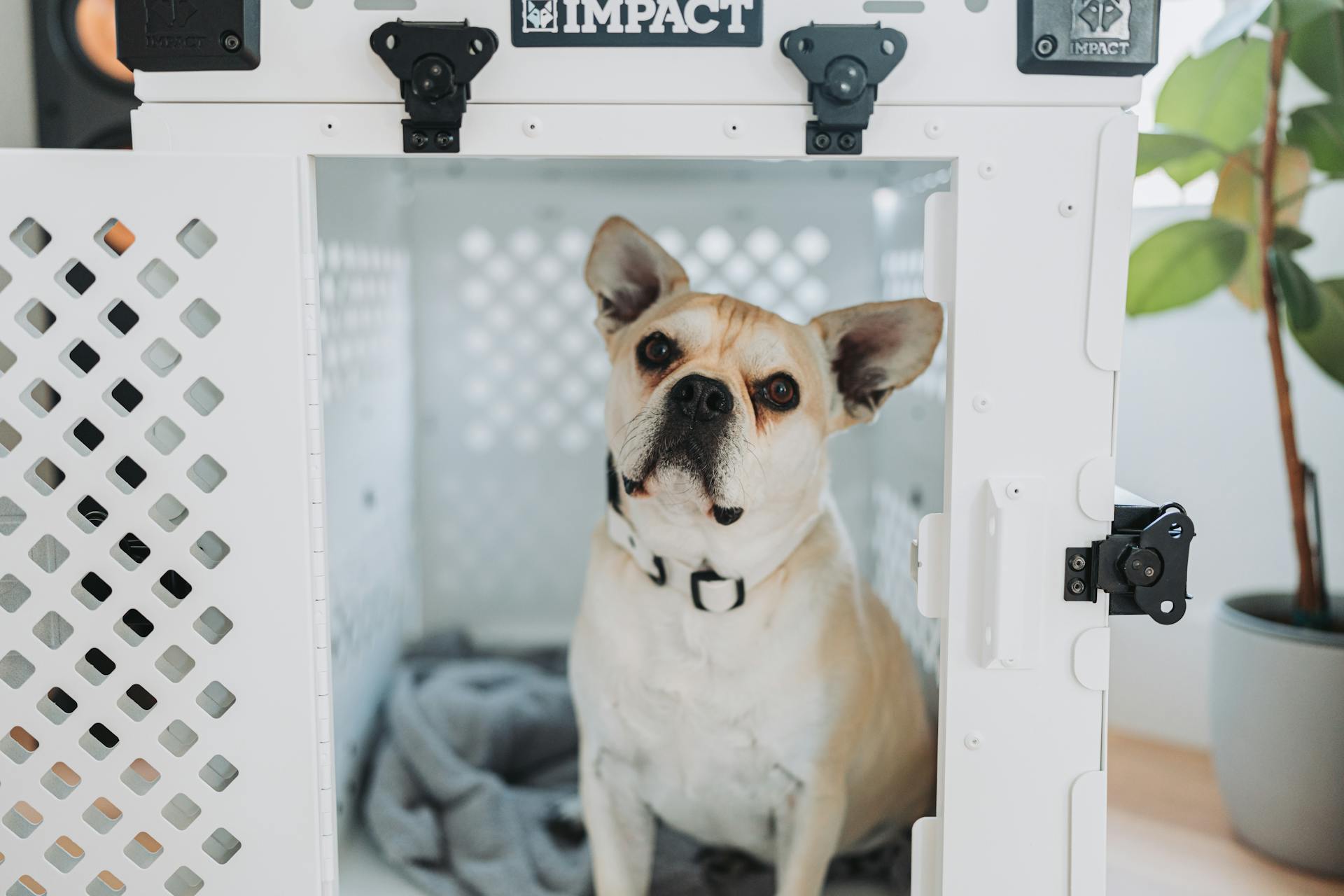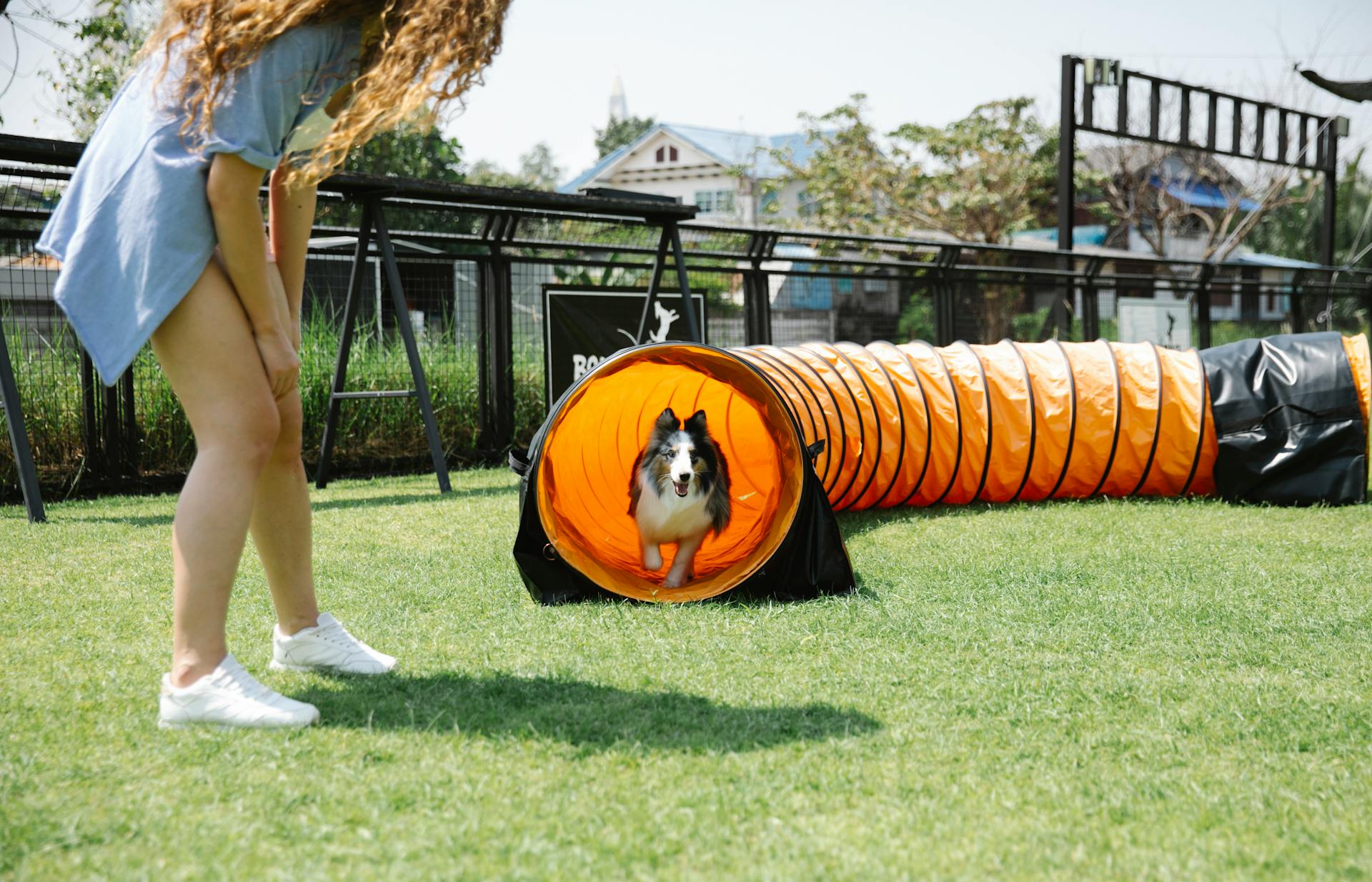
Crate training is a game-changer for dog owners who want to establish a sense of calm and structure in their home. By providing a safe and comfortable space for their dog, crate training can help reduce separation anxiety and destructive behavior.
Crates can be introduced to puppies as young as 8 weeks old, and they can be a lifesaver for new dog owners who are still figuring out their pet's boundaries. With consistency and patience, crate training can become a valuable tool for any dog owner.
The crate acts as a den, allowing your dog to retreat to a quiet space when feeling overwhelmed or tired. This can be especially helpful for dogs who are prone to barking or whining due to anxiety or boredom.
Recommended read: Does Crate Training Help with Separation Anxiety
Why Crate Train?
Crate training is a great way to provide your dog with a sense of security and comfort, as dogs are naturally den animals that crave a cozy space.
Dogs will often choose to retreat to their crate voluntarily, rather than being confined to it.
In addition to its emotional benefits, crate training also offers practical advantages, such as preventing destructive behavior when left alone.
A crate becomes part of a dog's everyday life and somewhere they want to be, making it a valuable tool for dog owners.
Getting Started
Crate training is most effective when started as a puppy, as it's easier to establish good habits and prevent unwanted behaviors from forming. Puppies are also more receptive to crate training because their slate is clean.
Start by using food to lure your dog into the crate, and leave the door open so they can come and go as they please. This helps them associate the crate with a safe space.
It's also essential to choose the right size crate for your dog, with enough space for them to stand up, turn around, and lie down comfortably. A general rule of thumb is to select a crate that's large enough for your dog to stand up to their full height and turn in a circle comfortably.
A different take: Dog Stand Training
Here are some key considerations to keep in mind when selecting a crate:
When to Start
When to start crate training your dog is a crucial decision. It's preferable to start crate training as a puppy when your dog has a clean slate.
Crate training is a simple process, but it's not a quick one - it takes time and patience. Puppies are the easiest to crate train because there aren't any behaviors established yet.
For puppies, crate training is also the easiest way to work on potty training. Leaving your puppy free to roam around the house at night is very likely to result in accidents.
Worth a look: What Age to Start Crate Training
Start with Food
Starting with food is a great way to get your dog comfortable with their crate. Use a piece of kibble to lure your dog inside the crate, all the way to the back, so they're fully inside.
This technique helps your dog associate the crate with a positive experience. Leave the door open, so your dog can easily come back out after getting the kibble.
Here's an interesting read: Inside Dog Training

As you repeat this training session over a couple of days, your dog will start to feel comfortable in the crate. Don't force your dog into the crate, and let them dictate the pace of training.
Here are some tips to keep in mind as you start with food:
- Always give your dog a potty break before putting them in the crate.
- Don't crate your dog for too long, as this can lead to accidents.
- Feeding your dog's meals in their crate with the door open can help make it a positive spot.
Remember, the goal is to make the crate a comfortable and safe space for your dog. With patience and positive reinforcement, your dog will learn to love their crate in no time!
Crate Training Techniques
Crate training is a gradual process that requires patience and time. Don't force your dog into the crate, and let them dictate the pace of training.
It's essential to give your dog plenty of time to feel comfortable inside the crate before closing the door and leaving them alone for the first time. This will help them associate the crate with a safe and comfortable resting spot.
To crate train your dog, you should start by giving them a potty break before putting them in the crate, and take them outside immediately after letting them out. This is crucial, especially for puppies whose "hold time" is still developing.
Don't crate your dog for too long, as this might force them to soil inside. For adult dogs, avoid crating them for more than four hours. For puppies, their "hold time" is roughly their age in months translated to hours.
Feeding your dog's meals in their crate with the door open can help make it a positive spot. If they're reluctant to eat inside, place the bowls next to the crate for a few meals, then just inside of it, then finally, at the back of the crate.
If your dog still isn't settling into the crate, they may be experiencing separation anxiety or discomfort. Check out our tips on dealing with dog separation anxiety and puppy separation anxiety in particular, and talk to your vet for advice tailored to your unique pup.
Here are some key tips to keep in mind when crate training your dog:
- Give your dog a potty break before putting them in the crate
- Take them outside immediately after letting them out
- Don't crate your dog for too long
- Feed their meals in the crate with the door open
- Don't use the crate for punishment
Teaching your dog to come out of the crate under control and calm is an essential part of crate training. To do this, work on having them pause at the crate's threshold, then reward them with a treat when they come out. Lure them back into the crate and give them another treat, repeating this session as needed.
Part A: Leaving
Leaving your dog crated can be a great way to help them feel safe and secure when you're not around. You should start by leaving them crated for short periods when you leave the house, about 30 minutes at a time.
To begin, put your dog in the crate using your regular command and a treat. You can also leave them with a few safe toys in the crate to keep them occupied.
Vary the moment during your "getting ready to leave" routine that you put your dog in the crate. You can crate them anywhere from five to 20 minutes prior to leaving.
Don't make your departures emotional and prolonged. Praise your dog briefly, give them a treat for entering the crate, and then leave quietly.
Here's a summary of the steps to follow:
- Put your dog in the crate using your regular command and a treat.
- Vary the moment during your "getting ready to leave" routine that you put your dog in the crate.
- Don't make your departures emotional and prolonged.
Managing Crating
To transition your dog to longer crating periods, you can start by confining them to the crate while you're home, but not in the same room. This will help them get used to the crate without feeling anxious or fearful.
Give your dog a treat and a voice cue to enter the crate, such as "crate." Encourage them by pointing to the inside of the crate with a treat in your hand.
After they enter the crate, praise them, give them the treat, and close the door. Sit quietly near the crate for five to 10 minutes, then go into another room for a few minutes.
Repeat this process several times a day, gradually increasing the length of time you leave them in the crate and the length of time you're out of sight. This may take several days or weeks.
Here's a step-by-step guide to help you increase crating periods:
- Start with short periods of 5-10 minutes, then gradually increase to 30 minutes.
- Leave the room for a few minutes, then return and sit quietly for a short time.
- Repeat this process several times a day.
Once your dog will stay quietly in the crate for about 30 minutes with you mostly out of sight, you can begin leaving them crated when you're gone for short time periods and/or letting them sleep there at night.
Crating Essentials
You'll need a crate that's large enough for your dog to stand up, turn around, and lie down comfortably. A good rule of thumb is to choose a crate size that will accommodate your dog's adult size, especially if you're crate training a puppy.
There are several types of crates available, including plastic, fabric, and collapsible metal pens. You can find crates at most pet supply stores or online, and some even offer adjustable sizes to accommodate growing puppies.
Some other essentials you'll need for crate training include bedding, treats, and toys. A simple crate mat is a good choice for puppies, as it's easy to clean and won't absorb accidents. Treats like Wellness Soft Puppy Bites can help reinforce good behavior inside the crate.
Here are some crate training supplies you may want to consider:
- Bedding: a simple crate mat like the Frisco Micro Terry Dog Crate Mat
- Treats: small savory treats like Wellness Soft Puppy Bites Lamb & Salmon Recipe Grain-Free Dog Treats
- Toys: busy toys like the KONG Classic or West Paw Zogoflex Small Tux Tough Treat Dispensing Dog Chew Toy
Supplies Needed
When choosing a crate, consider the type and size. A crate should be large enough for your dog to stand up, turn around, and lie down comfortably, but not too big, as this can derail the potty-training process.
You can find crates in various materials, including plastic, fabric, and metal. Some crates are adjustable, making them ideal for puppies that will grow into larger dogs.

To ensure your dog's comfort, you'll need bedding for the crate. A simple crate mat is a good choice for puppies still acclimating to the crate. Avoid extra-plush dog beds, as they can absorb urine and make it difficult to detect accidents.
Treats are a crucial part of the crate introduction process. Small, savory treats can help reinforce the idea that good things happen inside the crate. Wellness Soft Puppy Bites Lamb & Salmon Recipe Grain-Free Dog Treats are a great option.
You'll also need toys to keep your dog occupied and happy in the crate. Busy toys, like treat-stuffable toys, can help keep your dog focused and calm. The KONG Classic and West Paw Zogoflex Small Tux Tough Treat Dispensing Dog Chew Toy are durable options that can withstand most dogs' powerful teeth.
Here are some essential supplies you'll need for crate training:
- Bedding (e.g., a simple crate mat)
- Treats (e.g., Wellness Soft Puppy Bites Lamb & Salmon Recipe Grain-Free Dog Treats)
- Toys (e.g., treat-stuffable toys like the KONG Classic or West Paw Zogoflex Small Tux Tough Treat Dispensing Dog Chew Toy)
Where to Store
When choosing a spot for your dog's crate, consider a quiet area where your pup can rest but not feel isolated from the household. A corner of the living room or dining room is an ideal location.

You'll want to put the crate close enough to your bed so you can hear your dog ask to go out at night, especially for young puppies who need to go out for a potty trip. This is especially important if you have a puppy that needs to go out multiple times before morning.
If keeping the crate in your bedroom isn't an option, consider using a dog monitor near the crate so you can hear when your puppy needs a potty trip. This way, you can still hear your dog without having to have the crate in your bedroom.
It's a good idea to have two crates, especially if you have a larger dog that requires an oversized crate that's hard to move around.
Worth a look: Training Dog to Ring Bell to Go Out
Benefits and Recommendations
Crate training is a game-changer for dog owners, and it's not just a tool for puppies.
A crate is a safe and secure space for your dog to rest and relax, giving them a sense of protection and shelter. Dogs instinctively seek small spaces to create protective shelters for themselves.
Most veterinarians, trainers, and breeders recommend crate training dogs from a young age, as it's an essential part of housebreaking puppies. Dogs don't like to soil their sleeping quarters, so they learn to hold their bladders while in their crate.
Crate training helps establish boundaries within the home, making it easier to teach your dog what's acceptable behavior. It's also a great way to manage problem behaviors like jumping up or barking.
In emergencies, crate training can be the difference between safety and uncertainty. A cooperative dog that can quickly get into a crate saves crucial time during evacuations, reducing the chance of them getting lost or injured.
Having a crate-trained dog also allows them to stay with you during an emergency, as dogs typically have to be crate trained to remain in shelters with their owners.
Additional reading: Can Chihuahuas Be Trained
Frequently Asked Questions
Is it better to crate train a dog or not?
Crate training can be a valuable tool for housetraining and preventing destructive behavior, but it's essential to use it responsibly and in conjunction with proper training and socialization. Consider crate training if you're looking for a safe and effective way to help your dog feel secure and learn good habits.
Is crate training really necessary?
Crate training is a recommended practice for housebreaking puppies, as it helps them learn to hold their bladders and prevents accidents in the home. By crate training, you can establish good habits and a clean living space for both you and your dog.
How long should a dog be in a crate?
For healthy adult dogs, crate time should be around 4-6 hours, with a maximum of 8 hours. Prolonged crate confinement can be detrimental to their physical and mental well-being.
Is crate training stressful for dogs?
Crate training can actually reduce stress in dogs, providing a secure and comfortable space of their own. In fact, many dogs left out of crates are more anxious and stressed than those who are crate trained.
Should I put my dog in a crate at night?
Yes, crate training at night can provide a safe and comfortable environment for your puppy when you're not actively supervising. Consider crate training to ensure your puppy's well-being and learn more about how to do it effectively.
Sources
- https://www.koruk9.com/tips-and-tricks/benefits-of-proper-crate-training/
- https://www.humanesociety.org/resources/crate-training-101
- https://www.animalhumanesociety.org/resource/crate-training-your-dog-or-puppy
- https://be.chewy.com/how-to-crate-train-a-puppy-a-step-by-step-guide-from-an-expert/
- https://www.akc.org/expert-advice/training/why-crate-training-is-great-for-your-dog/
Featured Images: pexels.com


